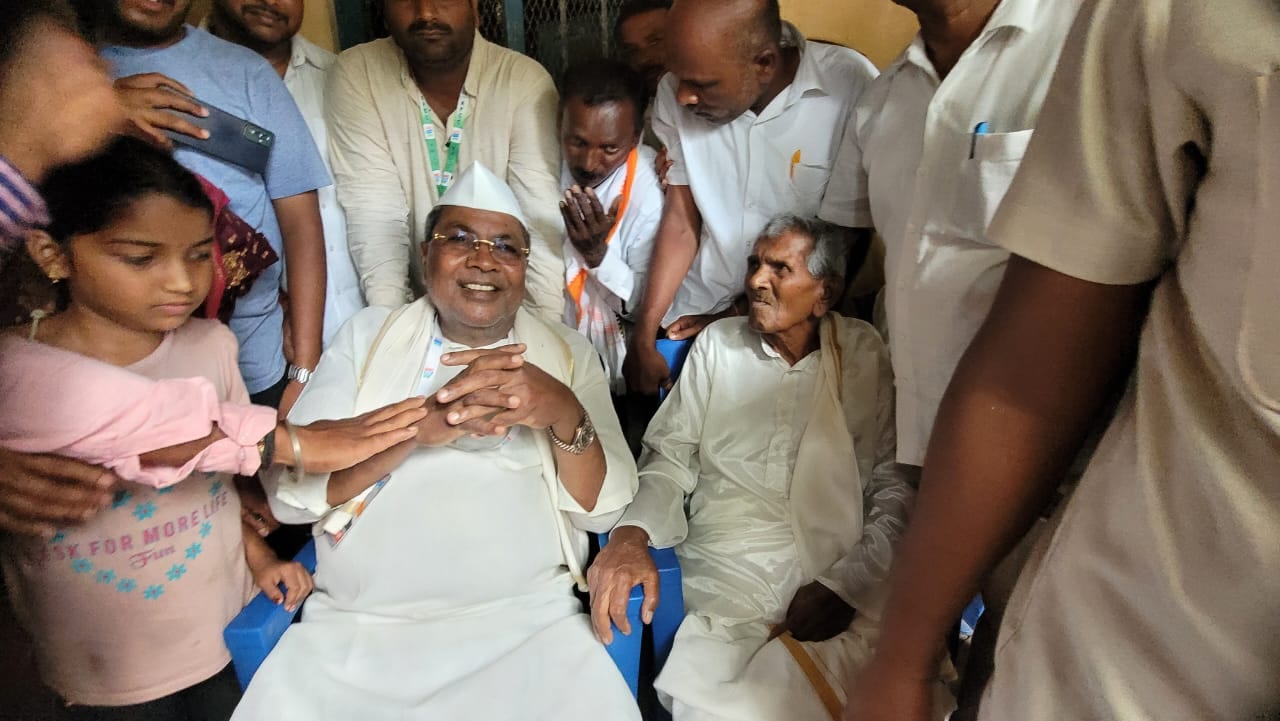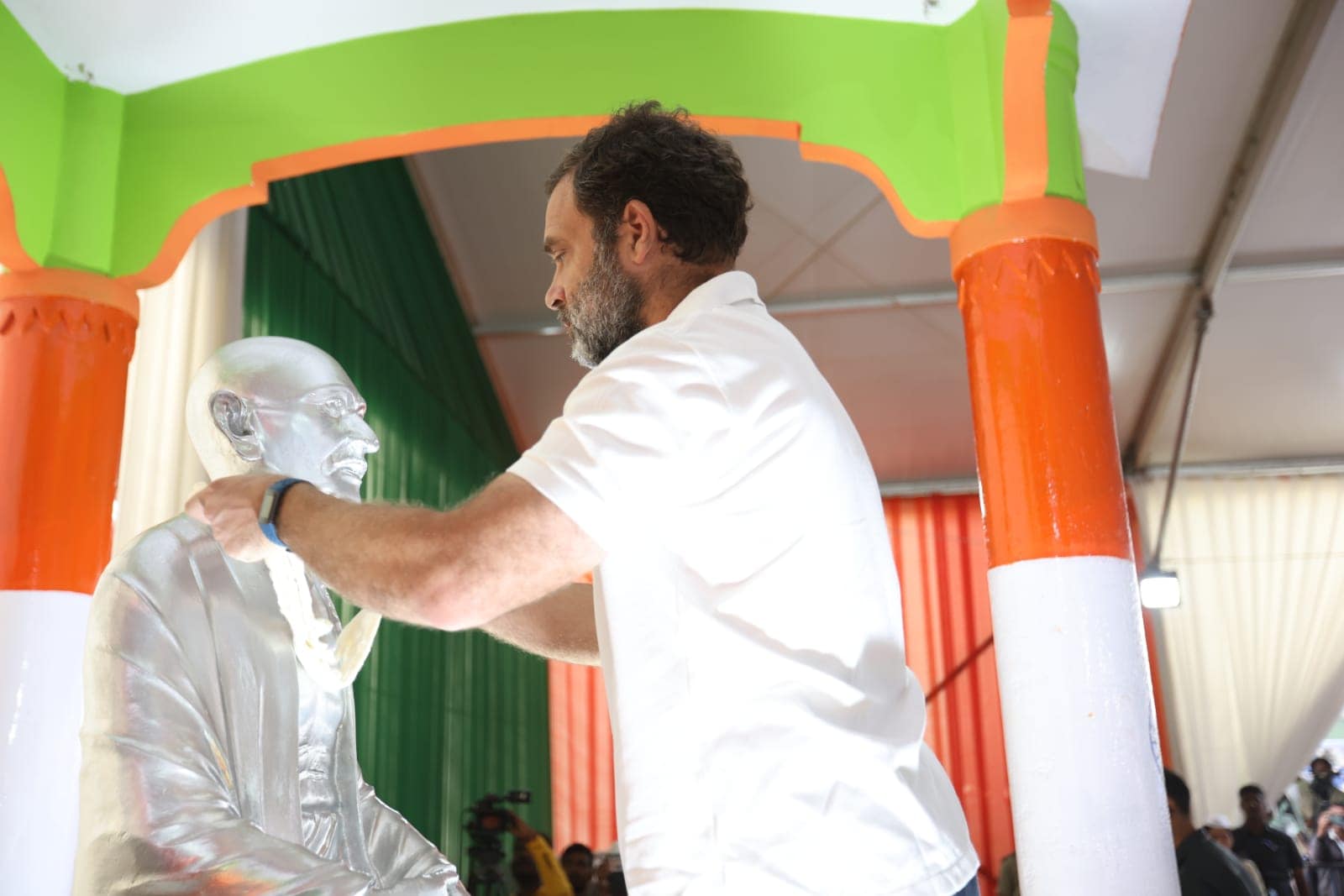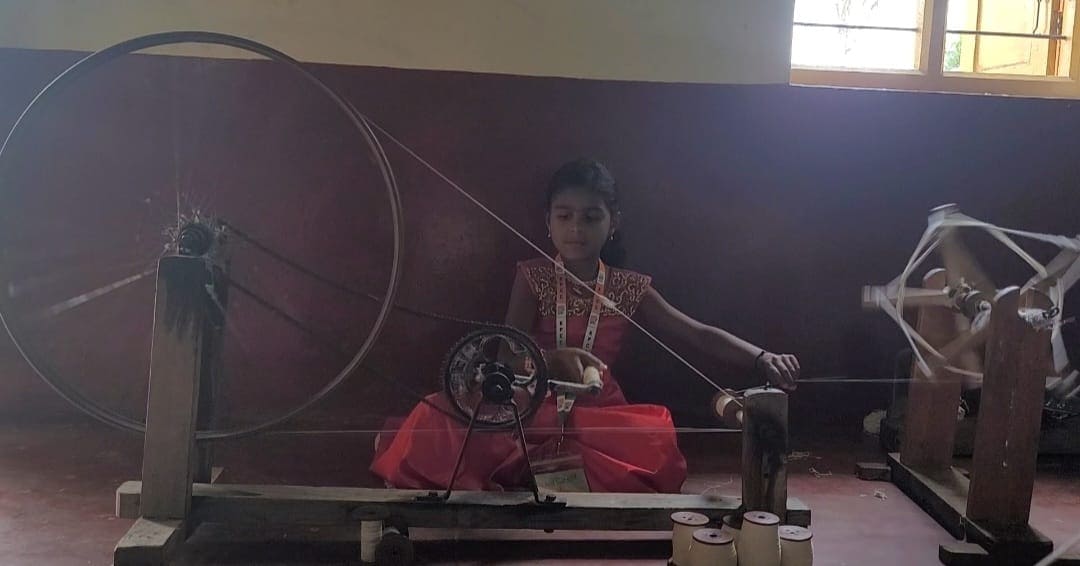Cherished by Gandhi-ji, This Khadi Village's Future Hangs by a Thread. Can It Still Weave Magic for Rahul?
By: Rohini Swamy
Edited By: Apoorva Misra
Last Updated: October 03, 2022, 13:08 IST
Karnataka, India

Rahul Gandhi interacts with weavers during his visit to the Badanavalu Khadi Gram Udyog centre in Karnataka's Nanjangud on October 2. (News18)
Located on a nine-acre campus with spinning wheels and units for weaving, paper-making, bleaching, and handloom, the Khadi centre played host to the Congress which camped at the premises for half-a-day as part of the Bharat Jodo Yatra
- Follow us:
![]() Nonagenarian Rangappa had a toothy grin all day after spending time with Rahul Gandhi and several Congress leaders who visited the Badanavalu Khadi Gram Udyog centre in Karnataka's Nanjangud on October 2.
Nonagenarian Rangappa had a toothy grin all day after spending time with Rahul Gandhi and several Congress leaders who visited the Badanavalu Khadi Gram Udyog centre in Karnataka's Nanjangud on October 2.
Badanavalu, a quaint village where Mahatma Gandhi inspired men and women to take up weaving Khadi, has a spinning centre that was established in 1927 by Tagadur Ramachandra Rao, an ardent follower of the Mahatma.
Located on a nine-acre campus with spinning wheels and units for weaving, paper-making, bleaching, and handloom, the Khadi centre played host to the Congress which camped at the premises for half-a-day as part of the Bharat Jodo Yatra. The centre also owes its glorious past to being the first such initiative that began operating with four Dalit women with an aim to uplift the community's economic condition.
Rangappa still vividly remembers watching Mahatama Gandhi use the spinning wheel when he visited the centre twice — once in 1927 and then in 1932. "I was this tall when I first met Mahatma Gandhi," he tells News18, pointing to his five-year-old great granddaughter standing by his side. He describes how he watched Mahatma Gandhi use the spinning wheel and when the latter sensed his curiosity, he offered the then-young Rangappa a ball of cotton.

"He showed me how to spin it. Tagadur was also there and he encouraged me to learn to weave and spin. It was mesmerising and I immediately took to spinning and weaving. Gandhi loved our people and when he came, the crowd was so big that we could hardly meet him. But he spent a lot of time in the village with us. Our village was very prosperous then," says Rangappa, who retired as the Khadi centre in-charge and also took part in the freedom struggle.
Cut to the present, Rangappa and his family — which included 10 children and 30 grandchildren — had a brief interaction with Rahul Gandhi. When asked what he thought of the meet, Rangappa smiled and slowly said: "I can only speak Kannada. They told me he wanted to know about me. I was happy sitting next to him. He has a very warm smile and is very nice." The nonagenarian then continued posing for photographs with senior leader Siddaramaiah, who he is very fond of, his family said.
Rahul Gandhi paid tributes to Mahatma Gandhi on his 153rd birth anniversary at the Khadi centre where he also interacted with the weavers and their families and participated in a 'bhajan' session.
Since Badanavalu is a village that set the tone for Dalit uplift, as part of that history, Rahul Gandhi also laid interlocking tiles of a lane that connected settlements of Lingayats and Dalits. This had special significance as in 1993, Badanavalu witnessed caste violence where three lower-caste farmers were killed by a group of upper-castes. Amidst protests, two others lost their lives in a police firing.

While the lore of the village has Mahatma Gandhi at its epicentre, at the heart of Badanavalu is the contribution by Tagadur Ramachandra Rao who insisted that the Mahatma visit his village in 1927.
Ramachandra Rao is lovingly called the 'Gandhi of Mysore' by his supporters who hailed from Tagadur, a village neighbouring Badanavalu. He actively participated in the freedom struggle and at the young age of 18, began to sell pictures of the Jallianwala Bagh massacre to earn a living.
While his small business was flourishing, the Swadeshi movement was gaining ground across the country. Rao, who drew inspiration from senior Congress leaders like Mudividu Krishna Rao, heard how foreign goods were burnt as a mark of protest. Since his products too were foreign-made, he immediately set his cart on fire and joined the Swadeshi movement.
Rao's work towards uplifting the Dalits and campaigns against untouchability earned praise from Mahatma Gandhi and Madan Mohan Malviya. Rao faced arrest in 1928 when he made a speech against the Mysore State and opposed the visit of the Simon Commission. He became the first political prisoner in Mysore State and spent 15 days in jail.
Talking about Badanavalu's legacy, senior Congress leader BL Shankar explains that Tagadur Rao forced Gandhi-ji to come to the village.
"When he (Rao) brought him here, Gandhi-ji was surprised how Dalits who were considered untouchables were weaving and spinning charkha to earn a living. At one point in time, there were more than 600 weavers in this village and it was flourishing," he said.
Shankar added: "When mechanisation began and power looms hit the market, these hand looms gradually disappeared. We brought Rahul Gandhi here today to show the beauty of Badanavalu, the village that impressed Gandhi-ji. This visit also showed how important it is to revive our village economy."
Third-generation weaver Shailaja, who spent a few minutes with Rahul Gandhi during his visit, said she continues to work in the Khadi centre because she is inspired by Mahatma Gandhi and wants to keep his memory as well as the tradition of Khadi alive.
"We have a lot of respect and adoration for Gandhi-ji. Even though we get a paltry salary and could have found work elsewhere, we are still here at the Khadi centre as we want to keep the tradition of Khadi alive — the same Khadi that Gandhi-ji gave to the country and used to make people self-reliant," she told News18.

When asked what Rahul Gandhi had to say to her, she said he asked about her job and their troubles. "Our problem is our salary. For a metre, we get Rs 25 and daily we weave only six to seven metres. How can we run our family with it? We need a hike in our salaries and we have given a letter to Rahul Gandhi requesting help," Shailaja said.
Shailaja's daughter, nine-year-old Harshita, quickly sat near a charkha and tried her hand at spinning. Though her mother reprimanded her for wasting thread, the little one kept insisting. "I also want to spin and weave like you. You like Gandhi-ji, I like him too," she said before she finally paid heed to her mother's advice.
In 2015, a movement called the 'Badanavalu Satyagraha' was launched by theatre personality and activist Prasanna which envisaged sustainable development while maintaining harmony with the environment. The Satyagraha attracted the likes of Medha Patkar and now late Bollywood actor Irrfan Khan to be a part of the revival story. The decline of Badanavalu and the perishing Khadi industry drove Prasanna to set up a home in the village and with the help of a few volunteers, he began to help revive the centre and create awareness about this quaint town that left the Mahatma impressed.
There have been suggestions to develop Badanavalu on the lines of the Sabarmati Ashram and the weavers of this village hope to see a brighter future as the future of the spinning industry hangs by a thread.
Read all the Latest Politics News and Breaking News here


comment 0 Comments
more_vert